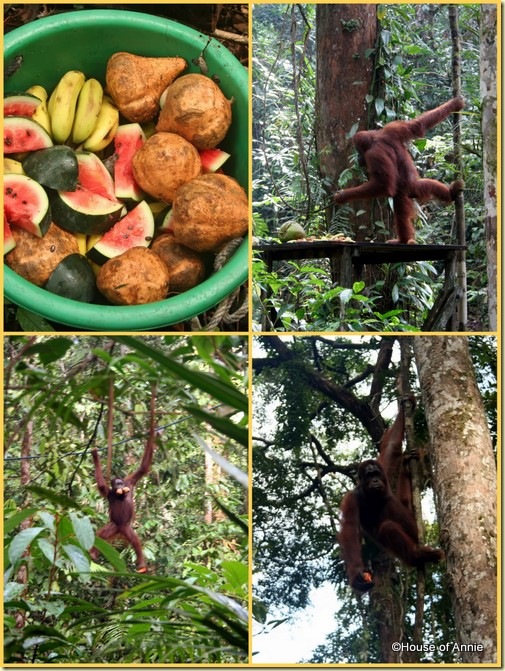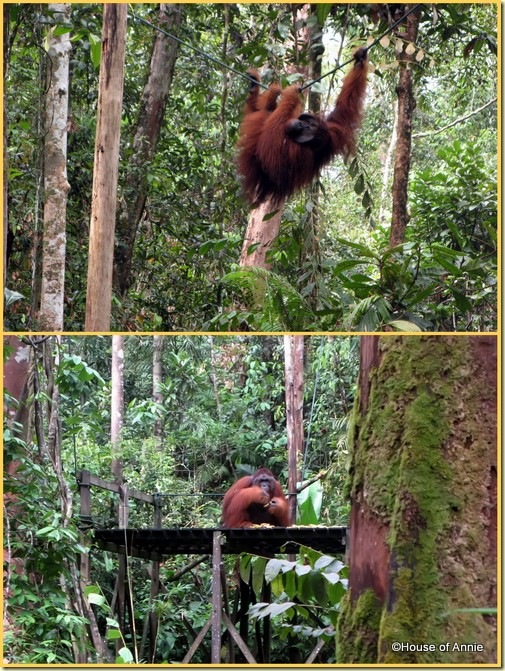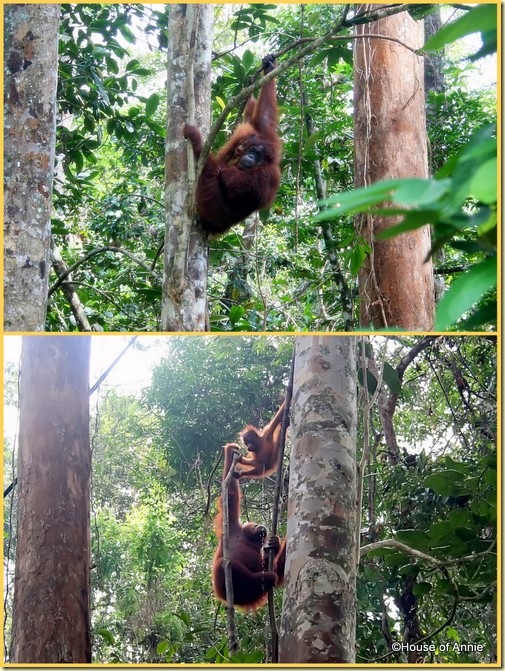Take a walk on the semi-wild side of Sarawak, and come face-to-face with some “men of the forest” – the endangered orangutan of Borneo.

Ever since I was a young boy, I’ve wanted to see orangutans. These graceful, red-haired great apes of the forest captured my imagination. The closest I actually came to seeing one was when we visited the San Diego Zoo. Clyde, the giant grandfather orangutan, sat quietly (and forlornly, I thought) with his back up against the glass enclosure. It was kind of a deflating experience for me.
So I was quite excited to find out from my coworkers that there was a nature preserve quite near to Kuching where you could go see orangutans. The best part about it is, it’s not a zoo where the animals are kept captivity behind bars or cages. These orangutans are free to roam the forest park! It’s actually the humans that are penned in.
Semenggoh Wildlife Rehabilitation Centre, Kuching
The Semenggoh Wildlife Rehabilitation Centre is located about 30 minutes’ drive south from Kuching. It’s part of the larger Semenggoh Nature Reserve, Sarawak’s oldest forest reserve which houses a botanical research centre, arboretum, gardens and trails. But the main attraction is the Wildlife Rehabilitation Centre and its orangutans.
Orangutans are found in the wild in only Malaysia and Indonesia, on the islands of Borneo and Sumatra. The name orangutan comes from the Malay word “orang” – meaning man – and “utan” – meaning forest. They are literally “men of the forest”.
Due to human activities such as deforestation, encroachment, poaching and the illegal pet trade, their numbers in the wild have dwindled such that they are now critically endangered. Several organizations, like the Semenggoh Wildlife Centre, work to rescue, rehabilitate, and reintroduce orangutans back to the wild in protected parks.
Typically, an injured or orphaned orangutan will be brought in and slowly taught how to fend for itself in the semi-wild environment of the centre. The apes are free to roam around the forest, foraging and even sleeping in the open. The rangers provide a small supplement of food for them each day, but not all of the orangutans show up at the appointed time to pick up their freebies. That means that the ones who don’t come are successful in finding enough food on their own!
Feeding Time
Feeding time is normally from 9AM to 10AM in the morning, then 3PM to 3:30PM in the afternoon. We opted to visit in the morning. After paying the nominal entrance fee, we drove up to the parking lot and then took a short walk downhill to the staging area. There, a ranger explained to us the rules: no smoking, no food or drink, and obey the ranger’s instructions at all times to keep you and the orangutans safe. Then, it was an easy hike along a well trod forest path to the feeding observation area.
The actual feeding platform is located in a clearing about 50 meters from the roped-off observation area. Ropes are strung between the larger trees leading to the platform. The ranger set out some food: bananas, watermelons, sweet potatoes and even a coconut. Then, everyone waited with bated breath.
Soon enough, we could hear branches rustling and noticed dark shapes moving high among the forest canopy. Several orangutans were slowly making their way toward the platform. But they didn’t all come at once – orangutans are solitary creatures.
The first to arrive is a young male. Making his way to the platform, he munched on a few items before stuffing his mouth with more sweet potatoes, grabbing a tuber in each foot, and climbing back up and over a rope to a nearby perch. There he sat, quietly munching the rest of his food while posing for us camera-toting tourists.
Young Male Orangutan, Feeding @ Semenggoh
Big Daddy
The reason the young male had to move off so quickly was because Ritchie, the alpha male orangutan of the park, was coming. He was a beast, moving slowly and deliberately toward the platform. No one challenges Ritchie. Once he made it to the platform, he would not move. He just sat and ate at his leisure.
Ritchie is the bull of the park. The story goes that he fought with one of the other males in the park – and bit off the other male’s fingers from one hand. That male had to be moved to another park. Ritchie rules here.
Ritchie, the Alpha Male Orangutan of Semenggoh
Born to Be Wild
Semenggoh Wildlife Centre’s rehabilitation program has been so successful, they have had a large number of baby orangutan births to rehabilitated females. So many, that they actually don’t have enough space at the park for all of them. So now rehabilitated orangutans are being sent to other nearby forest reserves and parks.
At another feeding platform closer to the staging area, we saw two pairs of mothers with infant orangutans. They were so cute! The babies clung tightly to their mother’s fur while the moms descended to the platform to collect food and then climbed back up to their perch to eat in safety.
One of the little rascals waited for his mother to go pick up another helping of bananas, then tried to pee-bomb her as she made her way back up to him. Naughty boy! Should have gotten a spanking 😉
Mother and Baby Orangutan @ Semenggoh
I am really grateful for the opportunity to be up close and almost personal with these very person-like “men of the forest”. It makes me sad to think that deforestation and destruction in the name of human development may doom these defenseless creatures to extinction. At least organizations like Semenggoh are around to protect them.
No visit to Kuching would be complete without a visit to Semenggoh. Certainly, spend part of a day in North Kuching at the Sarawak Cultural Village. But definitely set aside a few hours to visit the orangutans at Semenggoh. You won’t regret it!
Semenggoh Wildlife Centre
A few km past 10th Mile (Kota Padawan) along route 1119
GPS Coordinates 1°23’59"N 110°19’27"E
Other reviews of Semenggoh on VKeong’s site, LWJuan’s site, Borneo Boy’s site, Orangutan Heather’s site, Travelblog.org





I’m glad you were able to fulfill your childhood dream of being up close and personal with these creatures. I always thought they got their names because of the orange color. Funny. For me, I’m not a fan, so looking at your photos will probably be the closest I’ll get to them.
I always thought they were called “orangutanG” as in Tang, the powdered orange drink. Chalk it up to the nasally American twang, I guess 😉
Just went here again few yesterday, I think it was my sixth visit there. 🙂 If you are a nature lover, I bet you will never get bored over viewing and observing the Orang Utans. Heard from the ranger, in the future, they might demolish the feeding platform to avoid the Orang Utans from fighting for food during the feeding sessions. Meaning, the rangers might feed them by throwing the food upward for them…sounds interesting 🙂
Chin,
yes, those orangutans are enthralling. When the rangers shoo us away at the end of feeding time, all of us are a little sad to leave. The great thing is, the park is so close to Kuching and the entrance fee is so minuscule that going back is a no-brainer.
I’d love to see the rangers tossing food to the orangutans. Wonder how high they can toss a coconut though.
Off hand, I think the word comes from ‘orang hutan’ which means men of the jungle.
OMG..I live in KCH all my life and this is one place I have not been to! Shame! Shame! Thanks for posting and sharing this story, AND reminding me to visit the Orangutan sanctuary when I’m in KCH next 🙂
IH –
as is the case in many places, the locals tend to avoid the “touristy” spots. There are so many places in Hawaii I’ve never been, not to mention California!
I do recommend going to Semenggoh, though. Unlike a monument or building, these creatures may not be around much longer.